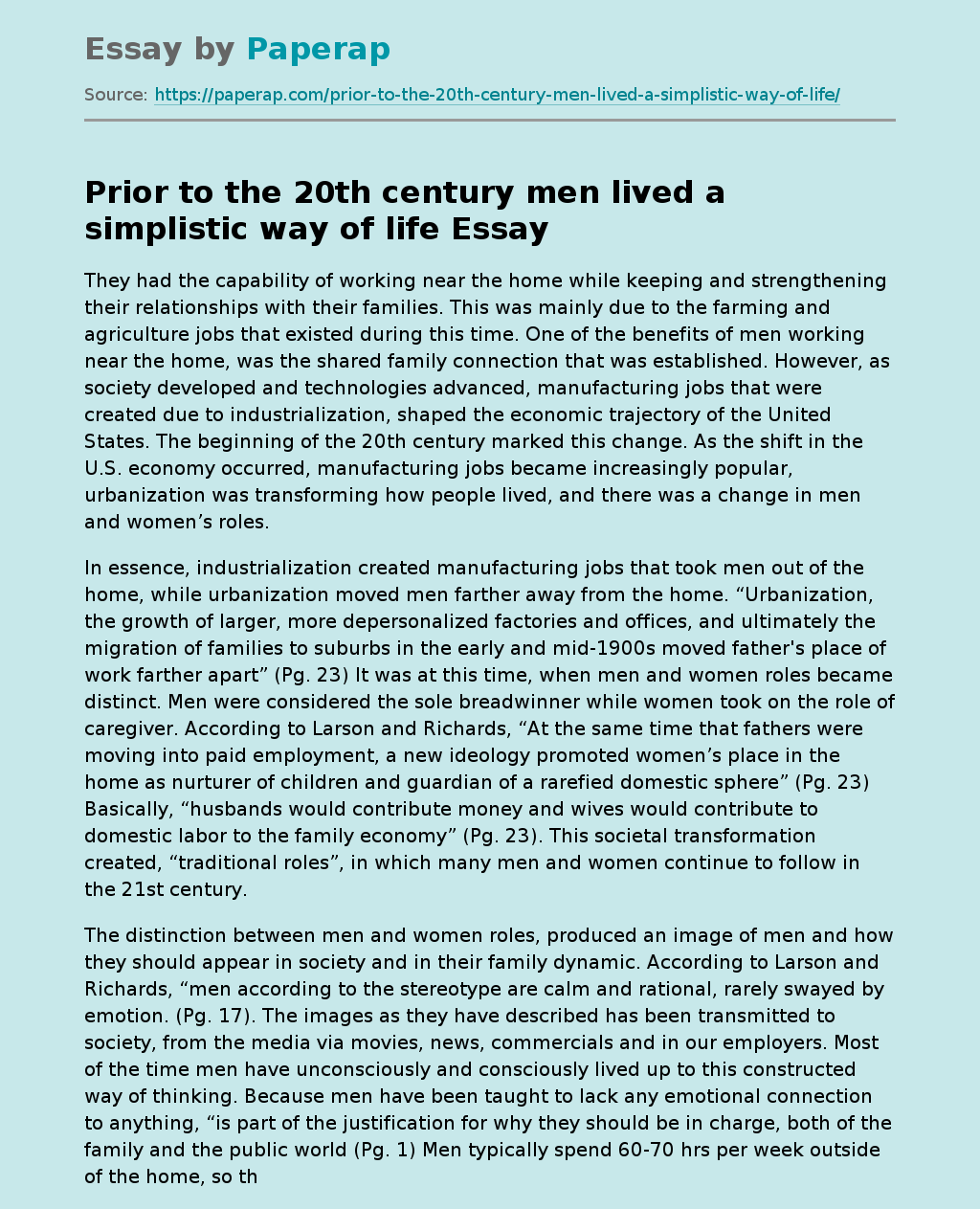Prior to the 20th century men lived a simplistic way of life
They had the capability of working near the home while keeping and strengthening their relationships with their families. This was mainly due to the farming and agriculture jobs that existed during this time. One of the benefits of men working near the home, was the shared family connection that was established. However, as society developed and technologies advanced, manufacturing jobs that were created due to industrialization, shaped the economic trajectory of the United States. The beginning of the 20th century marked this change.
As the shift in the U.S. economy occurred, manufacturing jobs became increasingly popular, urbanization was transforming how people lived, and there was a change in men and women’s roles.
In essence, industrialization created manufacturing jobs that took men out of the home, while urbanization moved men farther away from the home. “Urbanization, the growth of larger, more depersonalized factories and offices, and ultimately the migration of families to suburbs in the early and mid-1900s moved father’s place of work farther apart” (Pg.
23) It was at this time, when men and women roles became distinct. Men were considered the sole breadwinner while women took on the role of caregiver. According to Larson and Richards, “At the same time that fathers were moving into paid employment, a new ideology promoted women’s place in the home as nurturer of children and guardian of a rarefied domestic sphere” (Pg. 23) Basically, “husbands would contribute money and wives would contribute to domestic labor to the family economy” (Pg. 23). This societal transformation created, “traditional roles”, in which many men and women continue to follow in the 21st century.
The distinction between men and women roles, produced an image of men and how they should appear in society and in their family dynamic. According to Larson and Richards, “men according to the stereotype are calm and rational, rarely swayed by emotion. (Pg. 17). The images as they have described has been transmitted to society, from the media via movies, news, commercials and in our employers. Most of the time men have unconsciously and consciously lived up to this constructed way of thinking. Because men have been taught to lack any emotional connection to anything, “is part of the justification for why they should be in charge, both of the family and the public world (Pg. 1) Men typically spend 60-70 hrs per week outside of the home, so their emotions and emotional state, generally is expressed in their employment.
As early at the 18th century men have equated work with their identities (Pg. 24) and therefore put all their focus and energy into their jobs. According to Psychologist Daniel Levsion, there is a reason for this, “men discover a dream that drives their lives” (Pg. 24) Larson and Richards notes, “men have pursued their jobs as a seperate and emotionally consuming part of their lives that pulls them away from their families” (Pg. 24) This standard has shaped men’s behaviors and made it acceptable for men to live in this dimension. This ideology that men have subscribed too, is transmitted in their interaction at home. At home, men feel like home is a place for leisure and anything that is equated to working in the home, they feel resentful. “Many men resent the family pressures, that required them to work; as a result, they feel home is there domain to do what they want” (Pg. 32) This way of thinking causes conflict in the home and leave women feeling unsupported and undervalued.
Since the start of the industrial revolution, women roles have been constructed as such, that they provide the nurture and care as well as domestic duties to their families. In addition to work in the home, some women also work full and part-time jobs. A re-defining moment in women roles in terms of work or being the “breadwinner” came, during WWII. While men were sent to war, women took the lead and provided financial stability in the home. Jobs that were previously, provided to men based on sex, were completed by women. As Larson and Richard notes, “During World War II, women’s employment rose dramatically as ladies were asked to perform jobs such a welder and riveter, previously thought feasible only for men” (Pg. 49) Once this transition occurred, the public’s perception changed about women’s strength and her abilities as a dominant figure in the workforce. However, the respect that women garnered during this time, came to a halt when men returned home from the war.
To discourage women from continuing down this path of independence, advertising was partly responsible for constructing an image that a woman’s place is in the home, in addition to loss of jobs. “Motherhood became glorified and home, as deemed the proper place for young women” (Pg. 49) The belief that a woman’s place is in the home has been ingrained in the mindset of our society and this train of thought, has continued through the 21st century. However, Richard and Larson’s research has refuted this claim by demonstrating that women have always worked in and outside of the home. As research suggests, women have always experienced tremendous pressures to keep their families intact, including but not limited to supporting their husbands’ dreams and working to maintain the home’s financial security. The perception that women belong in the home is a fallacy that goes beyond what has been previously taught
Prior to the 20th century men lived a simplistic way of life. (2021, Dec 05). Retrieved from https://paperap.com/prior-to-the-20th-century-men-lived-a-simplistic-way-of-life/

